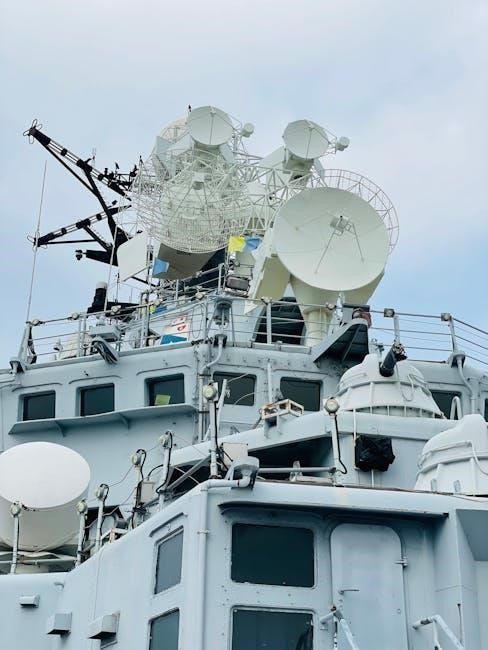The Navy Advancement Manual is a comprehensive guide outlining policies and procedures for enlisted personnel advancement. It details eligibility criteria, exam processes, and career development opportunities, ensuring sailors understand the pathway to promotion. The manual is updated regularly to reflect changes in advancement policies and technological advancements, such as the automation of the Enlisted Advancement Worksheet (EAW). Understanding this manual is essential for sailors seeking to advance in their careers within the Navy.
1.1 Overview of the Navy Advancement System
The Navy Advancement System is a merit-based process designed to ensure qualified sailors advance in rank. It uses a combination of enlisted advancement examinations, performance evaluations, and eligibility criteria to determine promotions. The system is governed by BUPERSINST 1430.16E, which outlines policies for advancement. Key components include exam development by the Navy Advancement Center (NAC), automated processes like the Enlisted Advancement Worksheet (EAW), and quota distribution. The system aims to ensure fairness, transparency, and consistency in advancing sailors, supporting their career growth and the Navy’s operational needs. Regular updates, such as the cancellation of E-4 exams in 2023, reflect ongoing efforts to refine the process.
1.2 Purpose of the Advancement Manual
The primary purpose of the Navy Advancement Manual is to provide clear guidance on enlisted advancement policies and procedures. It serves as a reference for sailors, commands, and personnel offices, ensuring consistency in advancement processes. The manual outlines eligibility criteria, exam administration, and career development opportunities, helping sailors navigate their advancement journey. It also addresses recent updates, such as the cancellation of E-4 exams in 2023, and the transition to automated systems like the Enlisted Advancement Worksheet (EAW). By standardizing procedures, the manual supports the Navy’s goal of fostering a skilled and competitive workforce.

Structure and Content of the Advancement Manual
The manual is organized into key sections, including eligibility criteria, exam processes, and recent updates like the cancellation of E-4 exams in 2023. It provides detailed guidance on advancement policies, ensuring sailors and commands understand the requirements for promotion. The document also references BUPERSINST 1430.16E, the governing instruction for advancement, and outlines the transition to automated systems like the Enlisted Advancement Worksheet (EAW).
2;1 Key Sections of the Manual
The manual is divided into essential sections, including eligibility criteria, exam administration, and advancement policies. It covers the Enlisted Advancement Worksheet (EAW), a tool transitioning manual processes to automation, and outlines recent updates like the cancellation of E-4 exams in 2023. The document also references BUPERSINST 1430.16E, the governing instruction for advancement, and provides guidance on quota distribution, exam ordering, and the role of the Navy Advancement Center (NAC). These sections ensure clarity and accessibility for sailors and commands navigating the advancement process.
2.2 BUPERSINST 1430.16E: The Governing Instruction
BUPERSINST 1430.16E is the primary instruction governing Navy enlisted advancements, issued by the Chief of Naval Personnel. It outlines detailed policies and procedures for determining eligibility, preparing necessary forms, and effecting advancements. The instruction covers key aspects such as promotion criteria, exam administration, and record maintenance. It also addresses changes in rating and provides guidance for commands to ensure compliance with advancement regulations. Regular updates to this instruction reflect evolving policies and ensure alignment with the Navy’s strategic goals. Understanding this document is crucial for sailors and commands navigating the advancement process effectively.

Eligibility Requirements for Advancement
Eligibility for Navy advancement requires meeting specific criteria, including time-in-rate, performance evaluations, passing advancement exams, and completing required training. Additional factors like education and conduct are considered.
3.1 Basic Eligibility Criteria
To be eligible for advancement, sailors must meet specific criteria, including time-in-rate requirements, satisfactory performance evaluations, and passing the relevant advancement exam. Additional factors such as completion of required training, education levels, and conduct are also considered. Sailors must be recommended by their commanding officer and meet physical fitness standards. These criteria ensure that only qualified personnel progress through the ranks, maintaining the Navy’s high standards of professionalism and readiness. Understanding these requirements is crucial for sailors aiming to advance in their careers.
3.2 Specific Requirements for E-4 to E-7
Advancement requirements vary by pay grade, with higher ranks demanding greater experience and performance. For E-4, sailors must meet time-in-grade requirements and pass the advancement exam, though exams were cancelled in 2023. E-5 candidates need longer time-in-grade, advanced training, and higher evaluation scores. E-6 and E-7 require even more extensive experience, superior performance, and completion of specialized courses. These criteria ensure leadership readiness and expertise, reflecting the Navy’s commitment to merit-based advancement. Meeting these specific requirements is essential for sailors aiming to progress to higher ranks and take on increased responsibilities within their ratings;

The Role of the Navy Advancement Center (NAC)
The Navy Advancement Center (NAC) develops and distributes enlisted advancement exams, evaluates candidates, and applies quotas from the Chief of Naval Operations to determine promotions for E5 through E9.
4.1 Development and Distribution of Exams
The Navy Advancement Center (NAC) is responsible for creating and distributing enlisted advancement exams for E5 through E9 pay grades. These exams are developed by subject matter experts to ensure relevance and accuracy. The NAC ensures exam security and integrity, with strict protocols for ordering, storing, and administering tests. Commands receive exams through the Navy Enlisted Advancement System (NEAS) website, with specific timelines for ordering and administration. This process ensures fairness and consistency across the fleet, enabling sailors to compete for advancement based on standardized criteria.
4.2 Evaluation and Ranking of Candidates
The Navy Advancement Center (NAC) evaluates candidates based on exam scores, performance evaluations, and award points. The NAC applies advancement quotas set by the Chief of Naval Operations to determine final rankings. Candidates are ranked within their rating and pay grade, ensuring fair competition. Commands receive results through the Navy Enlisted Advancement System (NEAS) website, enabling them to notify sailors of their advancement status. This standardized process ensures transparency and equity, allowing sailors to advance based on merit and fleet needs.

Enlisted Advancement Examinations
The Navy Advancement Center administers exams for Active Duty and Reserve personnel, ensuring fair competition. Exams are ordered via the Navy Enlisted Advancement System (NEAS) website, with specific cycles like Cycle 260. Recent updates include the cancellation of E-4 exams in 2023, streamlining the advancement process for sailors.
5.1 Types of Exams: Active Duty and Reserve
The Navy administers two primary types of advancement exams: Active Duty (AD) and Reserve. AD exams are for active-duty sailors, while Reserve exams are for Navy Reserve and Canvasser Recruiter personnel, including those on voluntary recall. Both exam types follow the same content and scoring standards but are administered separately to accommodate different service commitments. The Navy Enlisted Advancement System (NEAS) website manages exam ordering and administration, ensuring fairness and transparency. Recent updates, such as the cancellation of E-4 exams in 2023, highlight the Navy’s commitment to streamlining advancement processes for all personnel.
5.2 Exam Ordering and Administration
Exam ordering and administration are managed through the Navy Enlisted Advancement System (NEAS) website. Commands must adhere to specified timelines for ordering exams, with TIR (Timely Receipt of Exam) listings ensuring materials arrive on schedule. Security protocols are strictly enforced to maintain exam integrity. Recent updates, such as the cancellation of E-4 exams in 2023, reflect the Navy’s efforts to streamline advancement processes. Commands are responsible for administering exams, ensuring compliance with policies outlined in BUPERSINST 1430.16E. Proper administration is critical to maintaining fairness and transparency in the advancement process for all sailors.

The Enlisted Advancement Worksheet (EAW)
The Enlisted Advancement Worksheet (EAW) has transitioned from a manual process to an automated system, leveraging authoritative data to streamline advancement eligibility and promote accuracy and efficiency.
6.1 Transition from Manual to Automated Process
The Enlisted Advancement Worksheet (EAW) has shifted from a manual, paper-based system to an automated process within the Navy Standard Integrated Personnel System (NSIPS). This transition leverages authoritative data sources to enhance accuracy and efficiency. The automated EAW streamlines eligibility verification, reducing administrative burdens and minimizing errors. Sailors and commands now benefit from real-time updates and clearer advancement visibility. This modernization aligns with the Navy’s goal of improving personnel management and ensuring fair, transparent advancement opportunities. The automated system supports timely and precise advancement decisions, fostering career development and readiness across the fleet.
6.2 Features and Benefits of the EAW
The Enlisted Advancement Worksheet (EAW) offers enhanced features that improve the advancement process. It provides real-time eligibility status updates, automated record checks, and digital submission capabilities. Sailors can view their advancement profile, including performance marks and exam scores, in a centralized platform. Commands benefit from streamlined workflow, reduced paperwork, and improved tracking of advancement-related tasks. The EAW also ensures compliance with policies and procedures, reducing errors and discrepancies. These features promote transparency, accountability, and fairness, ultimately supporting sailors’ career progression and fleet readiness. The EAW is a critical tool in modernizing Navy personnel management.

Advancement Quotas and Determination
The Navy Advancement Manual outlines how advancement quotas are determined and allocated. The Chief of Naval Operations sets quotas, which are distributed by rating and pay grade. This ensures fair advancement opportunities, aligning with fleet needs and individual performance. Understanding quotas is crucial for sailors to navigate their career paths effectively.
7;1 Quota Distribution by Rating and Pay Grade
Advancement quotas are distributed by rating and pay grade to ensure alignment with fleet requirements and career progression needs. The Chief of Naval Operations sets these quotas, which are then allocated across ratings to reflect manpower demands. This system ensures fair opportunities for advancement while maintaining operational readiness. Sailors can access quota information through official Navy channels, such as the Navy Enlisted Advancement System (NEAS) website, which provides exam ordering dates and TIR listings. Understanding quota distribution helps sailors plan their careers effectively and stay informed about advancement opportunities within their specific rating.
7.2 Role of the Chief of Naval Operations
The Chief of Naval Operations (CNO) plays a pivotal role in the advancement process by establishing policies and guidelines that align with fleet readiness and career development goals. The CNO determines advancement quotas, ensuring they meet operational needs and reflect the Navy’s strategic priorities. This leadership ensures a balanced approach to promotions, maintaining fairness and transparency. The CNO’s decisions directly impact career progression opportunities for sailors, shaping the future of the Navy’s enlisted workforce and ensuring the fleet remains capable and ready to meet global challenges.

PERS-8031: Enlisted Advancement Work Requests
PERS-8031 manages enlisted advancement requests, including rate restoration and advancement determinations. Processing times vary, with EMF updates taking 1-2 weeks and other requests 6-8 weeks. Submissions are made through designated channels.
8.1 Time Frames for Processing Requests
PERS-8031 processes enlisted advancement requests with specific time frames. EMF updates are completed within 1-2 weeks, while restoration of rate and advancement determinations take 6-8 weeks. Requests are submitted via email to designated addresses for active and reserve personnel. Commands must ensure accurate documentation to avoid delays. These time frames are critical for sailors’ career progression and advancement eligibility. Adhering to these guidelines ensures timely processing and maintains the efficiency of the advancement system.
8.2 Restoration of Rate and Advancement Determination
PERS-8031 handles requests for the restoration of rate and advancement determination, typically processed within 6-8 weeks. Commands submit these requests, supported by detailed documentation, including NAVPERS forms and court or medical records. Restoration is considered for sailors whose advancement was delayed due to extenuating circumstances, such as medical issues or administrative errors. Accurate submission of required documents ensures timely processing. This process aims to correct records and provide fair advancement opportunities, maintaining the integrity of the Navy’s advancement system while addressing individual sailor circumstances.

Recent Updates and Changes
The Navy Advancement Manual has seen updates, including the cancellation of E-4 exams in 2023 and increased use of technology for automation and transparency in advancement processes.
9.1 Cancellation of E-4 Advancement Exams in 2023
In 2023, the Navy announced the cancellation of E-4 advancement exams for active-duty and TAR (Training and Readiness) sailors. This change aimed to streamline the advancement process, providing a more predictable path for sailors to achieve the E-4 rank. The cancellation aligns with efforts to simplify career progression and ensure sailors can make informed re-enlistment decisions as E-4 before their initial service obligation ends. This policy shift does not affect E-5 to E-7 exams or Reserve component advancements, which continue to follow established procedures.
9.2 Impact of Technological Advancements
Technological advancements have significantly transformed the Navy’s advancement process, enhancing efficiency and accuracy. The transition from manual to automated systems, such as the Enlisted Advancement Worksheet (EAW), has streamlined eligibility checks and reduced administrative errors. These tools leverage real-time data, ensuring sailors’ records are up-to-date and accurately reflected. Automation also supports faster processing of advancement requests and determinations, enabling sailors to focus on career development. Such innovations align with the Navy’s modernization goals, improving transparency and predictability in the advancement system while maintaining fairness and merit-based promotions.
Resources for Advancement
The Navy App Locker and official websites provide essential tools and references for sailors, including the Advancement Manual and BUPERSINST 1430.16E, to guide career progression effectively.
10.1 Navy App Locker and Useful Tools
The Navy App Locker offers a variety of digital tools designed to support sailors in their career advancement. These resources include the Advancement Manual, BUPERSINST 1430.16E, and exam preparation materials. Additionally, tools like the Enlisted Advancement Worksheet (EAW) and the Navy Enlisted Advancement System (NEAS) provide streamlined processes for tracking eligibility and managing advancement-related tasks. These tools are accessible online, ensuring sailors have convenient access to the information and resources needed to navigate the advancement process effectively and stay informed about the latest policies and updates.
10.2 Official Websites and References
Official Navy websites provide essential resources for advancement. The MyNavy HR website serves as the primary platform for personnel management, offering detailed guidance on advancement policies. Additionally, the Navy Enlisted Advancement System (NEAS) website provides exam schedules, quotas, and results. Sailors can also access the BUPERSINST 1430.16E, the governing instruction for advancement, which outlines eligibility criteria and procedures. These official references ensure sailors have accurate and up-to-date information to navigate their career advancement effectively. Regularly visiting these sites is crucial for staying informed about policy changes and exam cycles.

The Navy Advancement Manual is crucial for guiding sailors through promotion processes. Understanding it is vital for career growth and adapting to future advancements.
11.1 Importance of Understanding the Advancement Manual
Understanding the Navy Advancement Manual is crucial for sailors to navigate career progression effectively. It provides clear guidelines on eligibility, exams, and promotion processes, ensuring transparency and fairness. Familiarity with the manual helps sailors prepare for advancements, such as the 2023 E-4 exam cancellation, and adapt to policy changes. It also outlines the role of key organizations like the Navy Advancement Center and PERS-8031, which manage exams and personnel records. By staying informed, sailors can make informed decisions about their career paths and align with the Navy’s evolving strategic priorities.
11.2 Future Trends in Navy Advancement
Future trends in Navy Advancement emphasize technological integration and streamlined processes. The shift toward automated systems, like the Enlisted Advancement Worksheet (EAW), highlights a focus on efficiency and accuracy. The cancellation of E-4 advancement exams in 2023 reflects a broader effort to modernize promotion criteria. Additionally, advancements will likely prioritize individual performance metrics and specialized skills to meet evolving mission demands. The Navy Advancement Center (NAC) will continue to play a pivotal role in adapting policies to ensure transparency, equity, and alignment with strategic goals, shaping the future of enlisted career progression.

